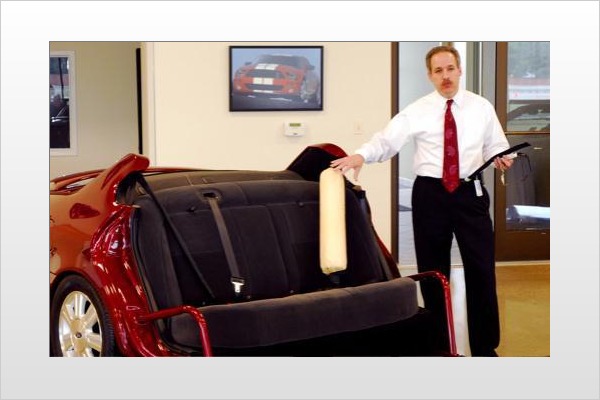
Safety belts save lives. Nobody argues with this statement, and some 82 percent of American drivers buckle up on a regular basis. Although the government legislated mandatory three-point safety belts decades ago, the design of these belts has seen only incremental improvements over the years, such as height-adjustable shoulder belts and pre-tensioners.
Manufacturers have been searching for the next major step forward in safety belt performance. Recently, Ford Motor Company showed two advanced prototypes that will likely see production by 2010: inflatable safety belts and four-point safety belts.
Inflatable rear safety belts
The first system looks just like conventional three-point safety belts. Careful inspection reveals that a portion of the shoulder belt is slightly thicker. A strap of airbag material is hidden in the seatbelt webbing that runs across the shoulder. During an impact, the strap-mounted airbag inflates into a cylindrical shape. The inflated belt spreads out forces from the crash over a broader section of the body compared to the traditional belt. Spreading out the force helps to reduce the pressure on the chest, lessening the chance for breaking bones or damaging internal organs.
Ford safety engineers noted that in ongoing testing, even soft-tissue injuries were rare in the severe head-on 35-mph barrier testing. This success attests to the new system's effectiveness.
Ford designed the inflatable belts to be used in rear seats — front-seat occupants already have airbags to protect them. Ford would not commit to a date or vehicle type on which the technology would be introduced.
Four-point safety belts
If you've ever looked at the safety belts worn by racecar drivers, there seem to be straps everywhere — one over each shoulder, one across the lap and one coming up from between the legs. Some multibelt racing systems even include individual thigh straps. The point of all those belts is to keep the racer safely in his or her seat during crashes at frightening speeds.
While the three-point safety belts in consumer vehicles are designed to perform the same function as the more complex racing belts, their design is a significant compromise. Three-point belts simply do not offer the protection of a four-, five- or six-point belt system. The simple question is, why not mandate the use of these more effective systems? The answer is obvious to anyone who has watched a racer fasten his or her belts. They are cumbersome. They take too long to put on, and it would be difficult to get the public to comply.
Safety engineers at Ford were undaunted by the drawbacks of racing-specific belt systems and began working on a driver-friendly version of the belts early this decade. The motion of putting on the new belt is similar to putting on a backpack or a life preserver: Snap the buckle together over the chest, then pull the straps down to the waist.
Field testing of the new belt system confirmed what thousands of Ford's test subjects have already told them: The belts are easy to use and comfortable for a wide range of users. (Members of the press tried them in a Mustang, and all agreed that they were easy and comfortable.) Ford admits that the buckling action requires two steps and takes about one second longer to complete than using a conventional three-point belt, but its field research shows that users didn't mind.
When asked why four-point systems were not already in use, safety engineers noted that a major issue with four-point belts is that occupants tend to submarine (slide out) from under the lap portion of the belts. With racing-belt systems, the thigh or crotch straps prevent this. Ford's current solution is to use belt pre-tensioners that cinch up the lap belts to prevent the submarining.
Ford Motor Company currently holds two patents on its four-point design, and three more patents are pending. The company says its crash data shows superior performance compared to existing belt designs. There's a major hurdle the company must clear before these belts go into production: Four-point belts are against the law, because federal motor vehicle safety standards currently specify that only three-point systems are permitted. Ford is preparing to petition Congress for a change in this law.
Boomers may demand more safety
Crash test data confirms what common sense predicts: Older people don't tolerate crashes as well as younger people. Ford research quantifies this by noting that the chest of a 65-year-old has 72 percent less tolerance for the belt forces in a crash than someone between the ages of 16 and 35. Older adults tend to fracture or break bones in serious collisions, women more so because of their susceptibility to loss of bone strength. The four-point belt system helps to more evenly distribute the forces of a collision, reducing the chance of broken bones.
Since the oldest of the Baby Boomers are now nearing the big six-five, safety will continue to be a leading concern for automotive consumers. Demand for safety features favoring older drivers will likely increase. Ford seems to be ready. In our opinion, they can't get these two new belt systems to market quickly enough.